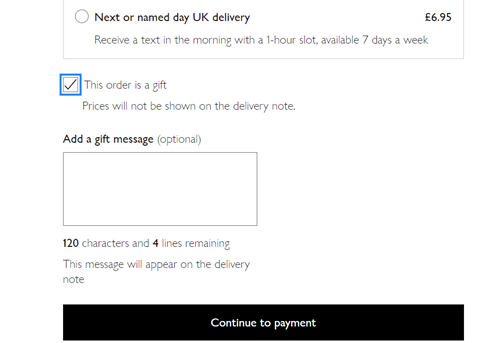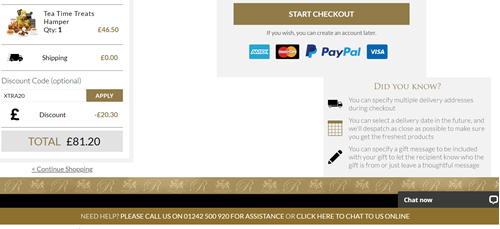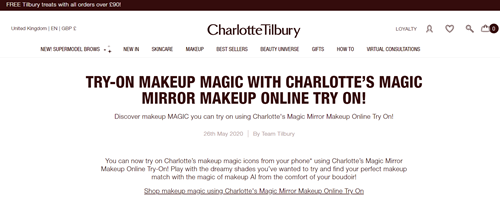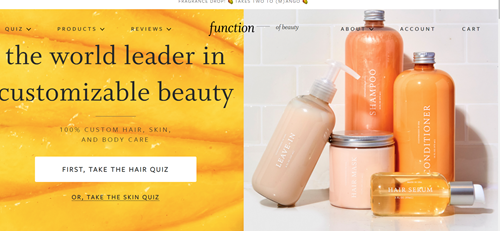5 mins
5 eCommerce trends to watch out for

Sending as a gift
The pandemic has kept loved ones apart for over a year now, with many of us spending special occasions at home, or at least celebrating them on a smaller scale. Unsurprisingly, this has led to a rise in online gift shopping, as consumers look for ways to bridge the physical distance caused by the lockdowns.
In fact, global searches for ‘online gifts’ increased by 80% in 2020 compared to 2019, according to Google{ 1 }. And the global gifts retailing market size is poised to grow by USD 6.45 billion during 2020 – 2024{ 2 }.
In my personal experience, sending presents like flowers and personalised cards through dedicated gift retailers has been easy. But it becomes a challenge when I want to send something a bit more unconventional, like homeware or clothing. Why? Because not every website is geared up to enable me to do so.
Some brands, like John Lewis, have recognised the growth in the digital gifting market and offer ‘send as a gift’ or ‘add a gift message’ options to their checkouts, enabling customers to add a personal touch to their order and hide the price on the delivery note.
Even though John Lewis isn’t what you would consider a traditional gifting business, giving customers this option broadens the brand’s market and appeal, and is more likely to boost conversion at the checkout.

Split delivery
Going one step further, split delivery gives customers the option to buy multiple items in one order and send them to different addresses or recipients. This is particularly helpful when gifting as it allows customers to shop from one website but send items to multiple locations with separate instructions, gift messages and delivery times.
Amazon has offered this service for a while now, but other retailers have started to implement it too. Luxury gift basket company, Regency Hampers, allows users to select multiple delivery addresses during the checkout, as well as choose a delivery date and add a message for each order.
In addition to making the online shopping experience easy and more flexible for customers, split delivery is a great way for retailers to differentiate themselves from similar brands. Of course, this won’t work for every retailer and the infrastructure must be in place to make sure the strategy can be implemented smoothly and successfully.

Interactive product visualisation
Brick and mortar retail has always had one advantage over online shopping: customers can see and feel the product they are looking to buy. But in recent years, the eCommerce industry has caught up, and interactive product visualisation tools are beginning to appear on an increasing number of websites.
Whether it’s how clothing will look on different body shapes or how home accessories will sit in your space, interactive product visualisation helps e-retailers bring their goods to life, whilst enabling customers to make informed decisions and be confident in their purchases.
Charlotte Tilbury is one brand paving the way for others to follow with its Magic Mirror Virtual Try On. Using camera mode on their smartphones, customers can see how the makeup will look before they go ahead and purchase – replicating the experience of buying at the beauty counter.
Not only does visualisation lead to higher conversion rates, it also allows for personalisation, increases a sense of participation and enhances brand loyalty.

Hyper-personalisation
According to a Royal Mail report, the UK subscription box market is forecast to be valued at £1 billion by 2022, compared to a £583 million estimated spend in 2017{ 3 }. And this rise in subscription eCommerce has given way to another growing trend: hyper-personalisation.
Hyper-personalisation is a marketing technique that leverages artificial intelligence (AI) and real-time data to offer customers bespoke products and services tailored to their specific needs and preferences. Essentially, hyper-personalisation serves your customer as an individual rather than part of a market segment based on assumptions.
You might have seen it with Amazon’s recommendation engine or Netflix emails detailing shows you might be interested based on previous interactions.
Function of Beauty is another brand using hyper-personalisation to its advantage. Founded in New York in 2015, Function of Beauty offers personalised hair, body, and skin care. New customers are invited to take a quiz to establish their beauty concerns and products are custom-made to suit, even down to the smell and colour of your shampoo.
Once their products have been ordered, customers get a reminder every three months encouraging them to re-order – much like reminders to order your repeat prescription.
Drilling down to this level of detail and customer insight means that the brand can offer a personalised service to each of its shoppers, in turn making customers feel more valued, engaged and loyal.

Incorrect delivery address prompts
On many occasions in the last year, I’ve ordered a product online that has been sent to my office because it was a default address in my online accounts.
Ordinarily, this wouldn’t be a problem as I’d be on site to intercept the parcels but now that I’m working remotely, it means I’ve had to cancel the orders. Clearly, this isn’t an ideal scenario for the retailer who has to process a refund and pay the courier for the delivery of an order that no longer exists.
However, a growing number of websites have started to notify customers when a business address is entered to double check it’s definitely where they would like their parcel delivered to.
By providing this additional prompt at the final checkout stage, retailers reduce the risk of late and failed deliveries, whilst improving the customer experience and boosting brand sentiment.
Another way to enhance the customer’s online journey is by implementing an address verification tool, much like Gymshark and Bloom & Wild have. As well as getting accurate data at the point of entry, address verification improves website usability and significantly reduces cart or form abandonment rates by providing a quicker way to enter address details.
Find out more about address verification or speak to a member of our team to find out how it could help your business.
{ 1 } https://www.thinkwithgoogle.com/intl/en-gb/consumer-insights/consumer-trends/gift-giving-during-pandemic/
{ 2 } https://www.businesswire.com/news/home/20201016005493/en/Global-Gifts-Retailing-Market-Growing-Popularity-of-Private-label-Brands-to-Boost-Market-Growth-Technavio
{ 3 } https://www.retailtimes.co.uk/uks-subscription-box-market-set-to-grow-to-1-billion-in-2022-finds-royal-mail/